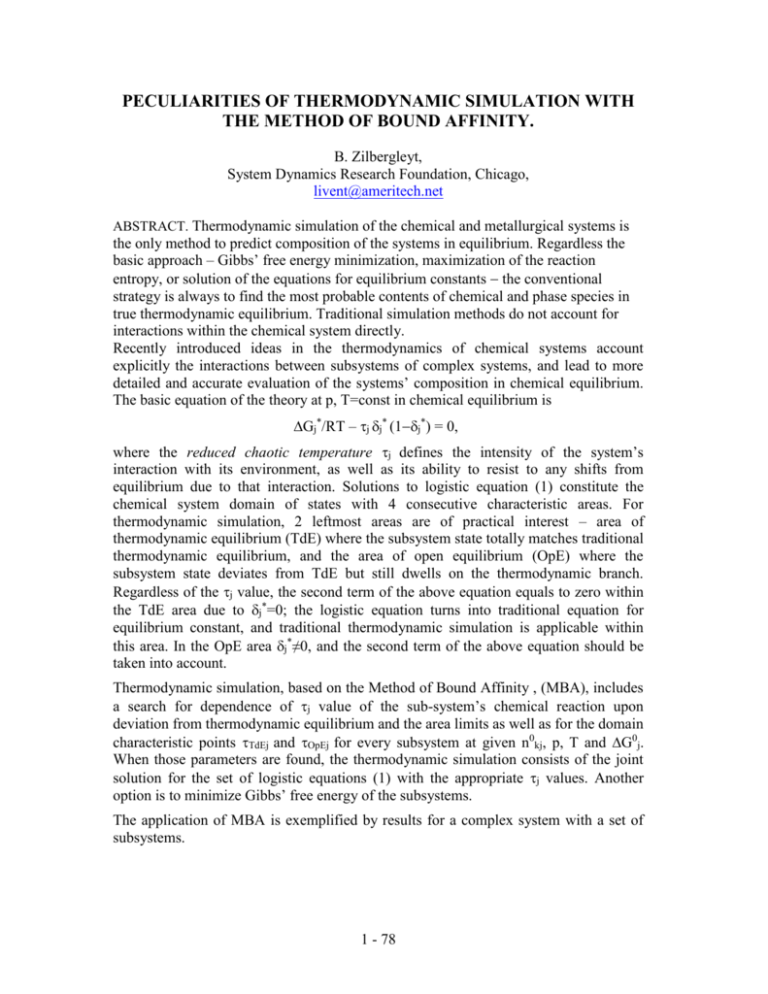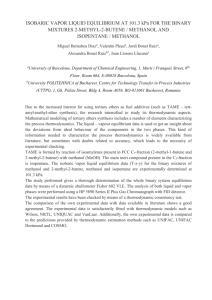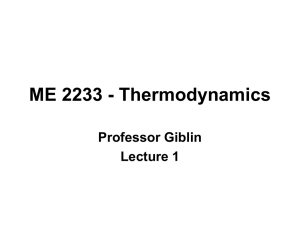Paper
advertisement

PECULIARITIES OF THERMODYNAMIC SIMULATION WITH THE METHOD OF BOUND AFFINITY. B. Zilbergleyt, System Dynamics Research Foundation, Chicago, livent@ameritech.net ABSTRACT. Thermodynamic simulation of the chemical and metallurgical systems is the only method to predict composition of the systems in equilibrium. Regardless the basic approach – Gibbs’ free energy minimization, maximization of the reaction entropy, or solution of the equations for equilibrium constants the conventional strategy is always to find the most probable contents of chemical and phase species in true thermodynamic equilibrium. Traditional simulation methods do not account for interactions within the chemical system directly. Recently introduced ideas in the thermodynamics of chemical systems account explicitly the interactions between subsystems of complex systems, and lead to more detailed and accurate evaluation of the systems’ composition in chemical equilibrium. The basic equation of the theory at p, T=const in chemical equilibrium is Gj*/RT – j j* (1j*) = 0, where the reduced chaotic temperature j defines the intensity of the system’s interaction with its environment, as well as its ability to resist to any shifts from equilibrium due to that interaction. Solutions to logistic equation (1) constitute the chemical system domain of states with 4 consecutive characteristic areas. For thermodynamic simulation, 2 leftmost areas are of practical interest – area of thermodynamic equilibrium (TdE) where the subsystem state totally matches traditional thermodynamic equilibrium, and the area of open equilibrium (OpE) where the subsystem state deviates from TdE but still dwells on the thermodynamic branch. Regardless of the j value, the second term of the above equation equals to zero within the TdE area due to j*=0; the logistic equation turns into traditional equation for equilibrium constant, and traditional thermodynamic simulation is applicable within this area. In the OpE area j*≠0, and the second term of the above equation should be taken into account. Thermodynamic simulation, based on the Method of Bound Affinity , (MBA), includes a search for dependence of j value of the sub-system’s chemical reaction upon deviation from thermodynamic equilibrium and the area limits as well as for the domain characteristic points TdEj and OpEj for every subsystem at given n0kj, p, T and G0j. When those parameters are found, the thermodynamic simulation consists of the joint solution for the set of logistic equations (1) with the appropriate j values. Another option is to minimize Gibbs’ free energy of the subsystems. The application of MBA is exemplified by results for a complex system with a set of subsystems. 1 - 78 INTRODUCTION. Practical applications of chemical thermodynamics are focused to a great extent on thermodynamic simulation of the chemical systems. The goal of the simulation is to find the most probable chemical and phase composition of the equilibrium system. Maximum probability corresponds to thermodynamic equilibrium, the only state classical theory and based on it methods can properly treat. The well-known Zeldovitch’s theorem [1], asserting a uniqueness of the equilibrium state for isolated system, forms a cornerstone of the application, thus prompting us to search that unique point in the space of states of the chemical system. In the most of up to now developed simulation software [e.g., 2,3,4], the standard search usually consists in finding out the global minimum of the whole system Gibbs’ free energy. In the contrary to the commonly accepted approach, recently reported new theory of chemical equilibrium as balance of the thermodynamic forces [5,6] is able to analyze wider scope of the system states. The new theory places the sought states of chemical equilibrium in the domain of states, specific for each chemical system. Depending upon the “strength” of the chemical reaction in the system, that generally might be characterized by standard change of Gibbs’ free energy, area of chemical equilibrium of a practical interest gets broken by two parts –namely thermodynamic equilibrium and the area of the open equilibrium. Chemical equilibrium in the first area totally matches classical thermodynamic equilibrium, the system considered an isolated entity, and the simulation algorithm doesn’t change comparing to tradition. The difference occurs when the system runs out of that area, ceases to be isolated, and new equation members to account in the simulation become essential. Currently we call the method, following from the theory the Method of Bound AffinityI. This article is discussing some peculiarities of the new approach in a particular case of constant pressure and temperature. SOME FEATURES OF THE MBA. One of the basic objects of the new theory is the domain of states of the chemical system - a set of dependencies between the system’s deviation from true thermodynamic equilibrium and a parameter characterizing system’s interaction with the environment, the reduced chaotic temperature [6]. The name of this parameter reminds that its increase leads the chemical system to bifurcations and chaos. At constant pressure and temperature, the system’s domain of states is represented by bifurcation diagram, constituted by a set of solutions to the equation for the system’s Gibbs’ free energy change, reduced by RT - a logistic equation with negative feed back ln[j(j,0)/j(j,j*)] j j*(1j*)=0. (1) * In this equation j is the reduced chaotic temperature; j is the deviation of the system’s chemical equilibrium from thermodynamic equilibrium in terms of reaction extent; it is positive if the system state shifted towards initial reacting mixture, and negative for the opposite direction; j(j,j*) is the mole fractions product of the j-reaction participants. Asterisk relates the values to the state of chemical equilibrium. A set of solutions to build the domain of states also can be obtained by minimization of the systems’ Gibbs’ free energy, reduced by RT G j*= nkj*) k/RT + nkj*) lnj(j, j*) j (j*)2/2 = min. (2) It is easy to see that both of them turn to the appropriate classical equations if j*=0, that is in true thermodynamic equilibrium of the isolated system. ____________________________________________________________________________ I In some works we called it a Method of Chemical Dynamics. Currently it seems more reasonable to return to the original name of the method, the Method of Bound Affinity (MBA) [7]. 1 - 79 A typical domain of states for a simple reaction PCl3+Cl2=PCl5. (3) is shown in Fig.1. The numbers at the curves define the thermodynamic equivalent of transformation j [6], the mole amounts transformed on the reaction way to equilibrium. 1.0 j* 0.101 0.240 0.474 0.5 0.713 0.870 0.950 0.0 0 10 TdEq 20 j 30 Fig.1. The part of the domain of states with positive deviations from TdE, reaction (3). The curve from zero point of the reference frame up to the fork bifurcations presents thermodynamic branch of evolution of the chemical system [8], and is apparently broken by 2 parts - the horizontal and ascending. The horizontal part is housing the states with zero deviation from thermodynamic equilibrium; this is the TdE area, restricted by the TdE limit value of j. The ascending parts before bifurcations are related to the open equilibria, or OpE area. In the first bifurcation the thermodynamic branch decays, splitting by two new non-stable branches. Further increase of the j value leads to the higher bifurcation period and eventually to chaos. Both equilibrium areas are typical for any direction of the system deviation from equilibrium, while bifurcations were found only in cases of the shifts toward initial reacting mixtures as it can be seen in Fig.2. Initial reacting mixture, =0 1.0 j* 0.5 TDE OPE Bifurcations 0.0 0Line of TDE -0.5 10 j 20 Exhausted reacting mixture,=max Fig.2. Two-way bifurcation curve for j=0.713. It is obvious from equations (1) and (2) that, depending upon the system states location in the domain, we have either classical case of isolated equilibrium with j*=0 where we do not have to take into account the j value in the calculations, or open equilibrium where we have to account for j. The TdE limit defines the transition from classical, conventional simulation to non-classical approach. Regarding the simulation problems, it occurs very important to know the domain of states area limits to apply proper algorithms. 1 - 80 AREA LIMITS AND REDUCED CHAOTIC TEMPERATURE. The area limits may be found by direct computer simulation given initial composition and thermodynamic parameters. At the same time the limits, TdE and OpE can be found analytically with a good precision avoiding any simulation. Recall that equation (1) contains 2 functions, logarithmic and parabolic. Both have at least one joint point at j*=0 (Fig.3) in the beginning of the reference frame, providing for a trivial solution to equation (1) and retaining the system within the TDE area. The curves may cross somewhere else at least one time more; in this case the solution will differ from zero, and number of the roots will be more than one. There is no intersection if d()/dd[ln`*]/d This condition leads to a universal formula to calculate TDE limit as TDE =1+jkjn0kjkjj 0 where n kj– initial amount and kj– stoichiometric coefficient of k-participant in j-system. We offer the reader to check its derivation. 20 j*(1-j*) 10 =72 ln[((j,0)/(j,j*)] 0 -0.5 =10 0.0 0.5 j* 1.0 -10 F() -20 Fic.3. The terms of equation (1) calculated for reaction (3), j=0.87 (T=348.15K). Though the area with j*<0 is more complicated, formula (5) is still valid in cases when the system gets exhausted by one or more of the reactants before the minimum of the logarithmic term occurs. In case of reaction A+B=C with initial amounts of participants, corresponding to 1, 1, and 0 moles, formula (5) may be simplified as TDEjj (6) Fig.4 shows the comparison between values of TDE obtained by iterative process and the calculated by formulae (5) and (6), reaction (3), in dependence on j. As concerns to the OpE limit, it physically means the end of the thermodynamic branch stability where the Liapunov exponent changes its value from negative to positive, and the iterations start to diverge. If the logistic equation (1) is written in the form of j(n+1)*=fjn*), (7) the OpE limit can be found as a point along the j axis where the | f`jn*)| value changes from (-1) to (+1) [9]. As of now, we do not have ready formula for this limit. 1 - 81 20 TdE 10 0 0.0 0.2 0.4 0.6 j 0.8 1.0 Fig.4. Calculated and simulated values TDE vs. j. Series о , Δ and □ represent results calculated by equation (4), equation (5) and simulated correspondingly, reaction (3). The dependence of the area limits upon standard change of Gibbs’ free energy for reaction (3) is shown in Fig.5. Apparently, the “stronger” is the reaction in the system, the more extended is its TdE area along the j axis; both limits, TdE and OpE get closer with the increase of negative G0j merging at its extreme value. 30 jlim. 15 Bifurcations OpE TdE 0 -20 Gj st. 0 20 Fig.5. The area limits on the bifurcation diagram jlim. vs. G0j, kJ/m, reaction (3). 1.0 PbO-RO j* SrORO 0.5 CoO-RO 0.0 0 20 40 TDFext. 60 Fig.6. Shift vs. TDF in homological series of double oxides, reaction of the double oxides with sulfur, HSC simulation. To perform calculations in the OpE area one has to know the value of j. The phenomenological theory offers several ways to find it. In the more general method, j can be found directly from equation (1) 1 - 82 j = ln[j(j, 0)/ j(j, j*)] / [j*(1j*)]. (8) Varying the j and j* values, one can create the domain of states as a reference table allowing for extraction of j during simulation, depending upon the first two parameters. An alternative method consists in finding the equilibrium composition and the appropriate j and j* values in the homological series of chemical reactions by varying the external TDF [5]. This point by point method is illustrated by Fig.6. Standard change of Gibbs’ free energy of the double oxide formation from oxides was accepted as the TDF. Needless to say that prior to finding j one has to find j for the reaction in question at given temperature. It can be done by any simulation method for thermodynamic equilibrium (at j*=0). EXAMPLES. The Method of Bound Affinity obviously consists of 2 steps – mandatory solutions for isolated subsystems precede solutions for the interacting subsystems. Following example is a graphical image of a hypothetical chemical system with 5 subsystems. We tried to show possible different locations of the subsystems in their domains of states in equilibrium. The internal pentagon connects the TdE limit values of the subsystems, the external does the same for OpE limit values; the pentagon with the marks connects conditionally simulated j values. 1 20 15 10 OpE limit Simulated j values 5 2 TdE limit 5 0 4 3 Fig.7. A flat radar presentation of the sub-system domains of states, hypothetic chemical system. Subsystem numbers are shown at the beams. How different may be results of conventional and MBA thermodynamic simulation? To answer this question, we used chemical systems with 2 subsystems where different reactions between a couple of double oxides and hydrogen can run. Double oxides were taken to reduce reaction activity of the basic oxides, in other words, to make the reaction less “strong”, allowing usage of non-zero parabolic term in the OpE area in calculations. For example, binding of CoO into CoO•TiO2 brings equilibrium reaction constant from 32.09 for CoO+H2=Co+H2O to as low as 0.684 for CoO•TiO2+H2=Co+TiO2+H2O. Simulation was carried using HSC and then MBA in mixtures of double oxides (Me1O•TiO2+Me2O•TiO2) with hydrogen at T=973.16 and p=0.1MPa; results are shown in Table 1. We used following 1 - 83 values of j, found by the point method for MeO and MeO•TiO2: reactions NiO and NiO•TiO2 with hydrogen j=29.04, for CdO-reactions j=21.13, for CoO-reactions j=18.57. Even if the used thermochemical data were far from perfect, the difference between results of classical and MBA simulations is quite discernable. Table 1. Comparison between results, obtained by conventional (HSC) and MBA simulations. Couple NiO*TiO2 CdO*TiO2 HSC 0.126 0.322 MBA 0.164 0.276 Equilibrium contents, moles Couple HSC MBA NiO*TiO2 0.088 0.157 CoO*TiO2 0.488 0.389 Couple CdO*TiO2 CoO*TiO2 HSC 0.208 0.437 MBA 0.258 0.380 CONCLUSION. Described peculiarities of the Method of Bound Affinity at constant temperature and pressure and ways to find area limits and running values of j, allow for application of the MBA to thermodynamic simulation of chemical systems. Results by a classical simulation method and the MBA are quite different; the new theory prompts us to consider the MBA results to be in better correspondence with real chemical systems. Some results of this work were presented in part earlier on [10]. REFERENCES. [1] Zel’dovich, Ya. J. Phys. Chem.(USSR), 1938, 3, 385. [2] Outokumpu HSC Chemistry; Outokumpu Research Oy, Finland, [3] [4] [5] [6] www.outokumpu.fi/hsc/brochure.htm, 2000. CEA: NASA Jet Propulsion Laboratory, http://www.grc.nasa.gov/WWW/CEAWeb/index.html, 2002. SolGasMix-PV, NESC9944, http://www.nea.fr/abs/html/nesc9944.html (last update 1986). Zilbergleyt B.: Equation of State of Chemical System: From True Equilibrium to True Chaos, http://arXiv.org/abs/physics/0204074 Zilbergleyt B.: Equation of State of Chemical System: From True Equilibrium to True Chaos, http://arXiv.org/abs/physics/0404082 Zilbergleyt B.: Russian Journal of Physical Chemistry, 52(10), 1978, p. 1447. [7] [8] Prigogin I.: The End of Certainty, New York, The Free Press, 1997. [9] Beck C., Schlogl F.: Thermodynamics of Chaotic Systems, Cambridge, Cambridge University Press, 1997. [10] Zilbergleyt B., Zinigrad M.: Thermodynamic Simulation Of Complex Metallurgical and Chemical Systems with The Method Of Chemical Dynamics, International Conference “Modeling, Control, and Optimization in Ferrous and Non-Ferrous Industry”, Chicago, TMS, 2003. 1 - 84







